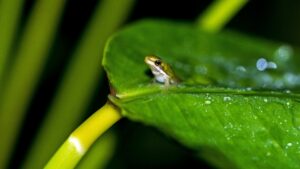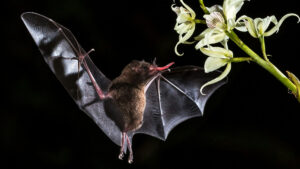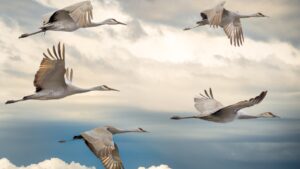The lives of nocturnal animals are shrouded in mystery and intrigue. These creatures have evolved unique adaptations and survival strategies to thrive in the darkness. From keen senses to specialized behaviors, they have mastered the art of living and hunting at night. Take a look at the fascinating adaptations and survival strategies of various nocturnal animals, shedding light on how they navigate their darkened habitats and succeed in their nightly endeavors.
Nocturnal Animals: Adaptations for Life in the Dark
Nocturnal animals have developed remarkable adaptations to excel in their nocturnal lifestyles. These adaptations primarily revolve around enhancing their sensory abilities and minimizing their visibility to predators.

Enhanced Night Vision
One of the most crucial adaptations for nocturnal animals is their enhanced night vision. Animals such as owls, bats, and cats possess specialized eyes that allow them to see in low-light conditions, as detailed by National Geographic. The retinas of these animals contain a higher number of rod cells, which are more sensitive to light than cone cells. This increased sensitivity enables them to detect even the faintest glimmers of light, making it easier to navigate and hunt in the dark.
Acute Hearing
In addition to superior night vision, many nocturnal animals rely heavily on their acute hearing to locate prey and avoid predators. Bats, for example, use echolocation to navigate and hunt insects in complete darkness. By emitting high-frequency sounds and listening to the echoes that bounce back, bats can create a mental map of their surroundings. Owls, too, have exceptional hearing, with asymmetrically placed ears that help them pinpoint the exact location of sounds.
Heightened Sense of Smell
A heightened sense of smell is another common adaptation among nocturnal animals. Many nocturnal mammals, such as foxes and raccoons, rely on their keen olfactory senses to find food. The large olfactory bulbs in their brains allow them to detect and distinguish between various scents, even in the absence of visual cues. This ability is particularly useful for locating prey or identifying potential threats in the dark.
Survival Strategies for Nocturnal Animals
Nocturnal animals employ a range of survival strategies to make the most of their nighttime activities. These strategies include specialized hunting techniques, communication methods, and defensive behaviors.
Stealth and Camouflage
Stealth and camouflage are vital survival strategies for nocturnal animals. Many nocturnal predators, like leopards and owls, have evolved to blend seamlessly into their surroundings. Their fur or feathers often have muted colors and patterns that mimic the environment, making them nearly invisible to both prey and predators. Additionally, these animals move silently through their habitats, reducing the chances of being detected.
Silent Hunting Techniques
Nocturnal predators have perfected silent hunting techniques to catch their prey off guard. Owls, for instance, have specialized wing feathers that enable silent flight. This adaptation allows them to swoop down on their prey without making a sound, increasing their chances of a successful hunt. Similarly, cats, both domestic and wild, move with incredible stealth, using their padded paws to approach their prey quietly.

Communication in the Dark
Communication is essential for nocturnal animals, whether it’s for mating, territory defense, or coordinating group activities. Many nocturnal animals use vocalizations, scents, and even bioluminescence to communicate in the dark.
Vocalizations: Frogs, owls, and wolves are examples of nocturnal animals that rely on vocalizations to communicate. These calls can serve various purposes, such as attracting mates or warning others of danger. The distinctive hoot of an owl or the howling of a wolf pack can be heard echoing through the night, carrying important messages to other members of their species.
Scent Marking: Scent marking is another common form of communication among nocturnal animals. Foxes, for instance, use urine and feces to mark their territories and convey information about their presence to other foxes. This form of communication is especially effective in the dark, where visual signals might be less effective.
Bioluminescence: Some nocturnal animals, like fireflies and certain marine species, use bioluminescence to communicate. This phenomenon involves the production and emission of light by living organisms. Fireflies, for example, use their bioluminescent flashes to attract mates. In the deep sea, bioluminescent creatures like jellyfish use light to lure prey or communicate with each other.
Ways That Nocturnal Animals Thrive in the Dark
Nocturnal animals have not only adapted to survive in the dark but have also developed ways to thrive. Their nightly activities often revolve around finding food, avoiding predators, and ensuring the continuation of their species.
Efficient Foraging
For many nocturnal animals, nighttime is the perfect time for foraging. The cover of darkness provides protection from predators, allowing them to search for food with relative safety. Nocturnal herbivores, such as deer and rabbits, take advantage of the cooler temperatures and reduced competition for food resources at night. Similarly, nocturnal insectivores like bats and hedgehogs find an abundance of insects to feast on during the night.
Avoiding Predators
The cover of darkness offers a significant advantage in avoiding predators. Nocturnal animals have evolved behaviors that help them stay hidden and minimize the risk of being caught. For example, many nocturnal rodents, like mice and rats, use intricate burrow systems to navigate their environment safely. These underground tunnels provide protection from predators and offer a safe place to rest during the day.
Reproductive Strategies
Nocturnal animals have developed reproductive strategies that align with their nocturnal lifestyles. Many nocturnal species engage in courtship and mating activities under the cover of darkness to avoid the prying eyes of predators. For instance, nocturnal birds like the nightjar perform elaborate courtship displays at night, using their calls and aerial acrobatics to attract mates. Similarly, nocturnal insects like crickets use their distinctive chirping sounds to find and court potential partners.
Hidden World of Nocturnal Animals

The hidden world of nocturnal animals is an incredible display of the diversity and adaptability of life on Earth. Through a combination of enhanced senses, specialized behaviors, and unique survival strategies, these creatures have mastered the art of thriving in the dark.
Observing their nocturnal activities opens up a new perspective on the natural world, highlighting the intricate balance and interdependence that sustain ecosystems. Each night, a dynamic and often unseen drama unfolds, revealing the resilience and ingenuity of these animals. As our understanding deepens, we not only appreciate their silent symphony of survival but also recognize the vital roles they play in maintaining the health and stability of our planet.
RELATED: How Do Birds Navigate When They Migrate? — Feathered Globetrotters
Header image: Bat with long tongue / Zdeněk Macháček via Unsplash
I’m Mark Putzer, and my passion for animals and all things nature is a life-long love affair. Growing up in Wisconsin, I had many cherished memories of hiking, skiing, and enjoying the abundant wildlife in the Badger State.
My passion for animals led me to marine biology research for my studies at the University of Wisconsin. I researched the behavior and communication of humpback whales around Hawaii and Orca Whales around the San Juan Islands of Washington State. The experience of being close to these massive and magnificent creatures is amazing. Later, I taught outdoor education to children in California — passing along my knowledge of animals and nature to the curious minds of the next generation. I also love pets. This includes a Labrador Retriever dog named “Molly” when I was a kid — and now, an adventurous tabby cat named “Rosy.”
I’m here to share the wonders of the animal kingdom with you. Whether it’s a cherished pet at home or an animal out in the wild, there are many unique stories and interesting information to share on Weird Animal News! Enjoy!





















